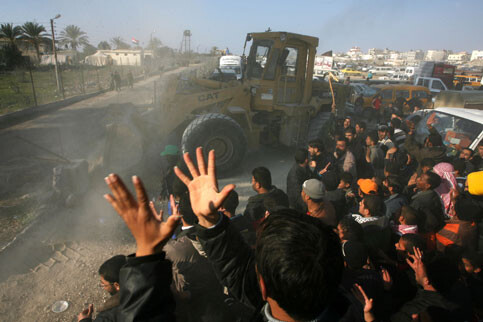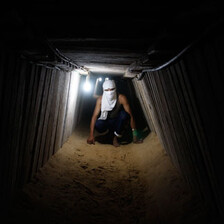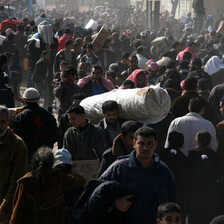The Electronic Intifada 29 January 2008

Palestinian wait cross to Egypt from the town of Rafah in the southern Gaza Strip, 25 January 2008 as a bulldozer destroys a section of the border wall. (Wissam Nassar/MaanImages)
It is 4:30 Friday morning and al-Arish’s souq is alive and packed with people. When asked where they are from, the inevitable reply with a broad grin is “I am from Palestine!” This sleepy Egyptian resort town nestled in the middle of the northern Sinai coast has been virtually transformed over the past 48 hours by a massive influx of Palestinians from Gaza.
Since the towering metal and concrete border wall that Israel began to erect in 2003 was demolished by Hamas early Wednesday morning, hundreds of thousands of Gazans have crossed the border with Egypt daily. Traveling by foot, car, truck, and donkey cart it is an unbelievable — almost indescribable — movement of people. The highway is jammed with packed taxis and pick-up trucks whose beds are filled beyond capacity and racing from Egyptian Rafah to al-Arish. Some journalists have called it a huge “jail break” and while the analogy to a prison is apt it does not accurately describe the horrors and humiliation suffered by Gazans during forty years of occupation and over 18 months of sanctions and siege. While this appears to be a temporary “break” in the siege, perhaps the best description of how Gazans feel is a deep exhale of relief and some joy — both rare commodities here.
Gaza’s economy has been devastated by the combination of sanctions since Hamas was elected in January 2006 and the siege after their militia defeated Fatah forces in June 2007. In the first 24 hours after the wall fell, Palestinians rushed to buy needed supplies which had become scare in Gaza, everything from gas to flour. Items barred by the Israelis from entering the territory during the siege were also among the first items purchased, including concrete, the lack of which has brought construction in Gaza to a halt.
As the border stayed open, many Palestinians returned to buy different consumer goods, including televisions and blenders, or stock up on different supplies. Some enterprising Palestinians were buying up as much as possible, either to sell immediately or once the border closed. A liter of gasoline could be purchased in Egypt for 20 Israeli shekels ($5 USD) and then sold in Gaza for 80 ($21 USD). Before the wall fell individual packs of cigarettes were almost unaffordable at 20 Israeli shekels ($5 USD), but by Saturday a carton was available for 70 Israelis shekels ($18). Motorcycles, rare and expensive in Gaza only a week before, were selling briskly. Indeed, those heading back toward Gaza all seem to be carrying some recent purchase, either food, fuel, or a household item.
During last month’s Eid al-Adha celebration, the traditional slaughtering of sheep was almost impossible for the vast majority of families in Gaza, as the few which were available were too expensive and underfed. In the past few days, sheep, goats and cows were being sold and brought into Gaza. As were Egyptian camels, which have been rare in Gaza since the occupation began. However, the price of meat is still prohibitively high across the territory, as the status of the border and consistent supplies remains uncertain.
Although the wall has come down, the siege continues. Rafah, which gets some power supplies from Egypt, still has daily blackouts of eight hours a day. Northern and middle Gaza, including Gaza City, which rely on Israel for the vast majority of their power needs, have less than eight hours of electricity a day. Israel’s resumption of fuel supplies has ensured that only the most basic needs will be met, in particular that of the health sector.
While the media has played up incidents of border violence, what is perhaps most remarkable is how few problems there have been since Wednesday. One is able to cross by foot between an international border with few controls or inspections in a manner that somehow manages to be chaotic and organized at the same time. In al-Arish, young men from across Gaza crowd the souq’s coffee houses and sandwich shops. An even greater number simply hang out, walking the city streets, talking, joking and smoking cigarettes, clearly enjoying the different scenery and “smelling new air.” The different squares in Rafah and al-Arish have become major gathering points, and there is barely a police presence within the towns except to guide traffic. Like Times Square on New Year’s Eve, the streets are littered with the detritus of thousands of plastic wrappers, paper, cans and cigarette butts. Indeed, it feels like a huge holiday, Independence Day and New Year’s Eve combined, but neither quite sums up the feelings of a brief respite or the underlying dread of what is to come next.
In contrast, Gaza’s streets are empty and eerily quiet. Stores are closed either for lack of goods, or because the owners have also gone to Egypt to buy needed supplies. Even shops that would normally open during holidays are shuttered. The lack of people and cars on normally busy streets provides a solemn backdrop to the silent gazes from Gaza’s ubiquitous martyr posters, constant reminders of the individual toll of the past eight years.
Gaza City is a ghost town and its al-Rimal district, once the center of the Oslo boomtown days, is deserted. Jundhi al-Majhool square adjacent to the Palestinian parliament building, once alive with activity in the afternoon, is now empty save a few children selling tea or candy and a Hamas security patrol shooing away curious photographers. Nor I am told, is this just because of the opening of the border. Since the fighting between Hamas and Fatah broke out over a year ago this area is no longer a meeting place for young couples and families.
It remains a fluid situation, fueled by constant rumors and speculation of when the border will be closed. Friday night Egyptian security forces, hoping to get Palestinians to return to Gaza, made a half-hearted announcement in al-Arish that the border would be closing. Although a greater number of forces were deployed Saturday morning, cars bearing Palestinian tags were in Egypt and Egyptian cars were seen in Gaza for the first time since the occupation began in 1967. The movement of cars was aided by the full opening of the Salah al-Din Gate by Hamas, using a bulldozer to push open the massive steel doors that were once an entry point for Israeli tanks and D-9 Caterpillar bulldozers. However, by Saturday evening Egyptian security forces were turning Palestinians back from al-Arish. Many made the long trek home by foot on a cold winter evening with scattered rain showers because taxi drivers had dramatically raised their rates, one indication of the subtler means of cutting the flow of Palestinians into the Sinai.

A Palestinian man takes in the unbroken horizon at the destroyed border wall, 25 January 2008. (Osamah Khalil)
The remnants of those houses remain, creating a vast moonscape of blasted concrete and sand, roughly a kilometer wide and several kilometers long. My friend Fida, a teacher and blogger from Rafah, points out where her house once stood, as well as those of her grandfather, grandmother, uncles, aunts, and other relatives. Beyond the sea of demolished houses are those still inhabited but riddled with bullet and shell holes, some dating from the beginning of the second intifada in 2000 and others more recent. Her young cousin Walaa explains, “this is our life,” and it sums up both realties.
Whether the destruction of the Rafah wall will change the reality of life in Gaza remains to be seen. Whatever the outcome, Hamas has managed to shock and embarrass the coalition allied against it for the third time in 24 months. It has demonstrated yet again that those who continue to try and ignore and isolate Hamas do so not only at their own detriment, but only prolong the inevitable and in the process increase the toll of human misery in a region that has already seen enough.
In part this has been due to the arrogance, incompetence, and maliciousness of its opponents in Israel, the United States, the Ramallah-based Palestinian Authority, Jordan and Egypt. Rather than attempting to negotiate with Hamas, and in the process helping to moderate some of its policies, the coalition pursued a policy of collective punishment of the Palestinian people. However, Hamas must now demonstrate an ability to build upon these actions and demonstrate that it can do more than just upset American and Israeli policies, but more importantly help build a future for the Palestinian people, especially in Gaza.
It is also unclear how the anti-Hamas coalition will respond. Although Fatah still has strong support in Gaza, Palestinian Authority President Mahmoud Abbas’ continued refusal to engage in national unity talks and power sharing appears to make him complicit in the siege of Gaza. In addition, Hamas has demonstrated that they could achieve what Abbas’ negotiations have not, a break in the siege, however brief. In spite of the attempts at damage control, for Israel and the United States this is nothing short of disastrous. Israeli Prime Minister Ehud Olmert could hardly afford another blunder after the Lebanon War debacle and he now has one.
Meanwhile, the Bush administration’s policy of punishing Gaza while “rewarding” the West Bank with aid and attention, while still supporting Israel’s occupation of both with even greater aid, is now in tatters. Moreover, the renewed peace process, which has yet to demonstrate a single improvement in the lives of Palestinians in spite of the claims of some delusional and self-serving proponents, will now be under even greater pressure to show results. It will be up to Washington to deliver them.
Yet, the past few days have demonstrated that there is more to the destruction of the Rafah wall than the simple Hamas-Fatah dichotomy or the endless inane commentary of its impact on the “peace process.” Hamas could destroy the wall, but unless Palestinians were willing to cross the borderline and face the threat of Egyptian security forces it would have been a futile gesture. That Palestinians went over that line again and again illustrates the powerful urge for freedom from oppression and occupation. More importantly, it demonstrates what Palestinians can do when they act as a collective body, not along factional lines but as a people.
The destruction of the Rafah wall was quite simply a victory of and for the Palestinian people. As I stare at the rusted hulk and watch children climbing and playing along and on top of it and the steady movement of people between the two Rafahs, I am reminded of my previous trips to Gaza and similar moments of elation that turned to bitter disappointment and tragedy. I can only hope that this time will be different and that this is but the first wall of many to fall in Palestine.
Osamah Khalil is a Palestinian-American doctoral candidate in US and Middle East History at the University of California, Berkeley. He can be reached at okhalil@berkeley.edu.
Related Links





